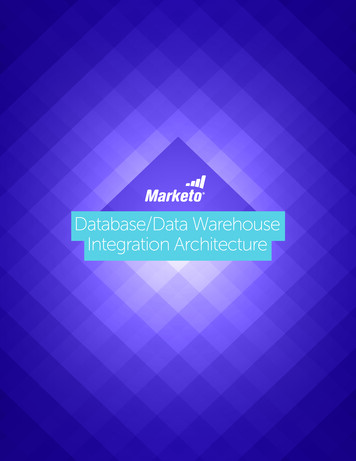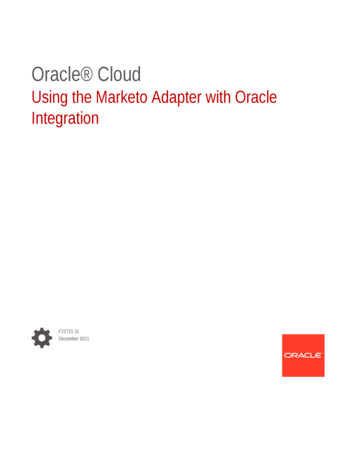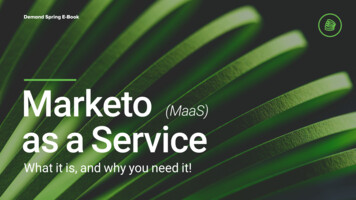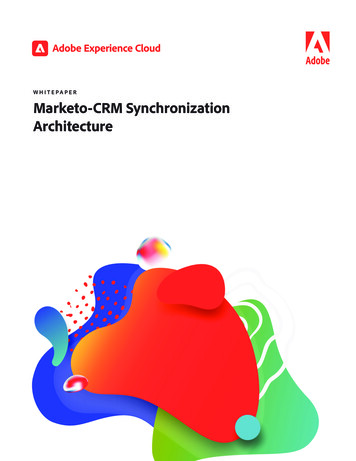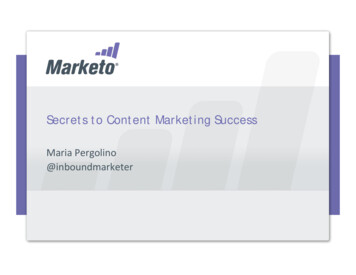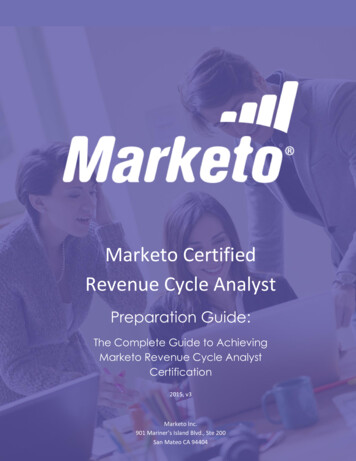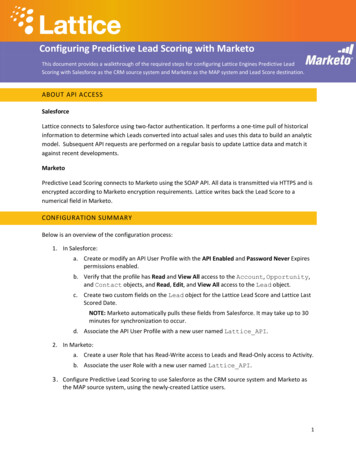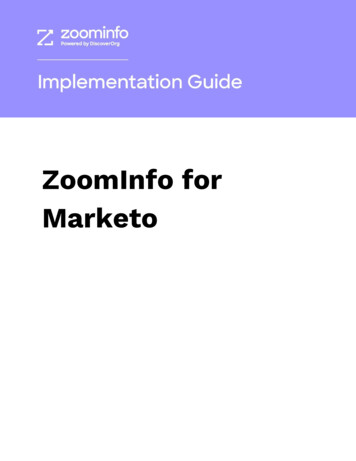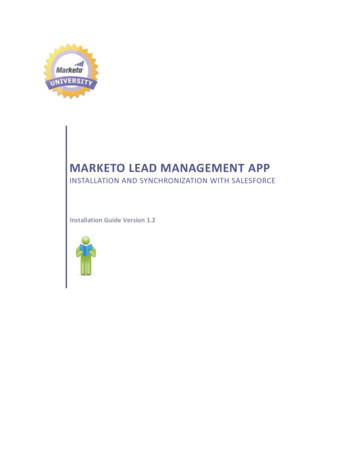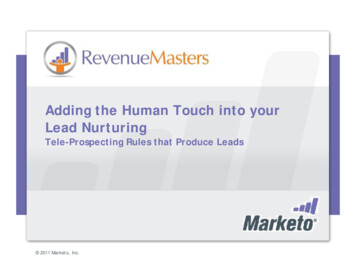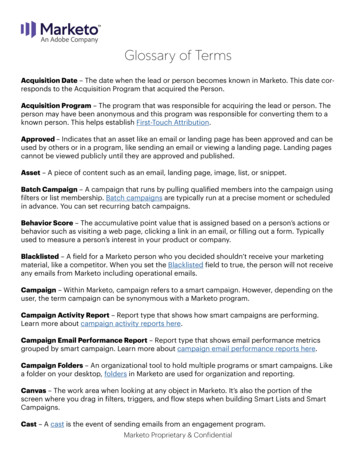
Transcription
Glossary of TermsAcquisition Date – The date when the lead or person becomes known in Marketo. This date corresponds to the Acquisition Program that acquired the Person.Acquisition Program – The program that was responsible for acquiring the lead or person. Theperson may have been anonymous and this program was responsible for converting them to aknown person. This helps establish First-Touch Attribution.Approved – Indicates that an asset like an email or landing page has been approved and can beused by others or in a program, like sending an email or viewing a landing page. Landing pagescannot be viewed publicly until they are approved and published.Asset – A piece of content such as an email, landing page, image, list, or snippet.Batch Campaign – A campaign that runs by pulling qualified members into the campaign usingfilters or list membership. Batch campaigns are typically run at a precise moment or scheduledin advance. You can set recurring batch campaigns.Behavior Score – The accumulative point value that is assigned based on a person’s actions orbehavior such as visiting a web page, clicking a link in an email, or filling out a form. Typicallyused to measure a person’s interest in your product or company.Blacklisted – A field for a Marketo person who you decided shouldn’t receive your marketingmaterial, like a competitor. When you set the Blacklisted field to true, the person will not receiveany emails from Marketo including operational emails.Campaign – Within Marketo, campaign refers to a smart campaign. However, depending on theuser, the term campaign can be synonymous with a Marketo program.Campaign Activity Report – Report type that shows how smart campaigns are performing.Learn more about campaign activity reports here.Campaign Email Performance Report – Report type that shows email performance metricsgrouped by smart campaign. Learn more about campaign email performance reports here.Campaign Folders – An organizational tool to hold multiple programs or smart campaigns. Likea folder on your desktop, folders in Marketo are used for organization and reporting.Canvas – The work area when looking at any object in Marketo. It’s also the portion of thescreen where you drag in filters, triggers, and flow steps when building Smart Lists and SmartCampaigns.Cast – A cast is the event of sending emails from an engagement program.Marketo Proprietary & Confidential
Change Status in Progression – Use this flow action to change the program status of a personwithin a program. For example, use this step to add people who received an invite email to anevent into your program with a status of Invited. Learn more about Flow Actions here.Channel – Type of marketing activity associated with a program – such as an email, webinar,tradeshow, roadshow, online advertising, etc. Learn how to create a program channel here.Child Campaign – A smart campaign that only lives and functions within a program. Childcampaigns are built to serve a specific purpose and specific goal within your program, such asnarrowing down a group of people and sending them a webinar invitation, or creating a triggercampaign that sends an email to a person when they complete a form in an online advertisingcampaign.Canonical Name (CNAME) Record – CNAME records map one domain name to another. Thiscan be helpful when creating aliases for your domain. Learn how to customize your landing pages with a CNAME here.Clone Program – Cloning a program is an action that creates an a new program with similar setup and assets as the one it was cloned from. This allows for easy re-use of existing programswith the same or similar structure.Company Web Activity Report – Report type that shows which companies are visiting yourwebsite. Note that you can choose to display either known or anonymous visitors but not bothin the same report. Learn more about company web activity reports here.Constraint – Additional criteria for a filter or trigger. For example, add a constraint to check forcertain IP addresses on a Visited Web Page filter.Content – Within Marketo, this refers to the asset placed in a stream of an engagement program. You can add single emails or entire programs to a stream. Content can also refer to informational elements included in an email or landing page, such as images, videos, blog posts,datasheets, etc.Content Engagement Level – A 0-100 point score that Marketo assigns content within theEngagement program. This number is determined by a sophisticated formula using opens,clicks, unsubscribes, program success, etc.Cookie – A small piece of data sent from a website and stored in a user’s web browser whilethe user is browsing that website. Every time the user loads the website, the browser sends thecookie back to the server to notify the website of the user’s previous activity.Design Studio – This is the area of Marketo where creative templates and global assets live suchas images and snippets.Marketo Proprietary & Confidential
Data Management – Marketo can actually be used for a host of data management functions.With Marketo, you can: Clean up duplicatesClean up errant field valuesRe-assign leads based on complex criteriaThis can all be done in the Database section of the platform. Many customers start with datamanagement activities before they send out their first mail.Decorated URL – Web addresses generated by Marketo sent by email to your people. When aperson clicks one of these URLs, Marketo can track their subsequent web activity and auto-complete their web forms.Default Program – A Marketo program type; default programs are used in cases where anevent, email, or engagement program are not appropriate.Demographic Score – A cumulative point value that is assigned based on specific attributes theperson has such as job title, revenue size, or target industry. Typically used to measure a person’s fit with your product or company.Design Studio – This is the area of Marketo where creative templates and global assets live suchas images and snippets.Domain Keys Identified Mail (DKIM) – DKIM is an authentication protocol designed to detectemail spoofing. It allows the email receiver to check that an email that claims to have come froma specific domain has indeed been authorized by the owner of the domain. Setting up DKIM canhelp improve your deliverability. Learn how to set up DKIM here.Domain Name System (DNS) – A hierarchical decentralized naming system for computers,services, or other resources connected to the internet or a private network. It associates variousinformation with domain names assigned to each of the participating entities.Draft – An email or landing page that hasn’t been approved yet. Draft assets aren’t available foruse in flow steps. Draft emails cannot be sent to people, and draft landing pages are not available publicly online.Dynamic Content – Content, such as text, images, or snippets that is pulled into an email orlanding page differently based on criteria. Dynamic content allows you to create one email orlanding page and personalize sections of the asset based on a specific segmentation. An example is to use dynamic content in order to display a different banner image in an email dependingon whether the person’s industry is healthcare, technology, retail, etc.Marketo Proprietary & Confidential
Engaged Lead/Person – Used to describe a person that is active with your content. An engaged lead/person has a behavior score point value that is greater than 0. The minimum number is often adjusted to be slightly higher based on the client’s requirements.Email – A Marketo design asset. Among other features, they have text and HTML versions, substitutable tokens (like First Names), and approval tracking.Email Invalid – A field indicating a person with an undeliverable email address. Typically thismeans Marketo tried to email the person, then the email hard bounced.Email Program – A Marketo program type; sometimes referred to as Email Batch Program, thisprogram type is used for one-time email sends. Users can specify the audience to send to, thespecific email to send, and the time at which to send the email out. Email programs have built-inA/B testing capabilities. Learn more about email programs here.Engagement Program – A Marketo program type; used to easily set up complex nurturing programs. Learn more about engagement programs here.Engagement Score – A numeric value that makes it easy to see how effective the content inyour engagement program is. The score ranges from 0 to 100 and is based on a proprietaryalgorithm that takes into account engaged behavior (Open, Click, Program Success) and disengaged behavior (Unsubscribe).Event Partner – Adapter integrations for a Marketo Event (i.e. WebEx, GoToWebinar).Event Program – A time-specific marketing initiative such as a webinar, seminar series, tradeshow, or road show. Events have a date or date range. Typically Marketo programs associatedwith events are an Event program type. Marketo has several Launchpoint partners with integrations into our event programs.Event Schedule – Lists the event’s Start Date, End Date, and Time Zone. It is accessed throughthe Event Actions drop-down menu in the Marketing Activities tab of your event programs.Exhausted – When a person has received every piece of content in an engagement streamwithin an engagement program it is has exhausted all its content options and is listed as “exhausted” until new content is added to that stream. Learn more about identifying people whohave exhausted content here.Filter – A tool used in a smart list to target campaigns at a specific set of people based on theirattributes and activity history such as Company Name, Geography, or Opened Email. Learnmore about filters here.Flow – A sequence of actions within a campaign for people who qualify for a smart campaign.Marketo Proprietary & Confidential
Flow Step – A single action taken against a person or set of people, such as Sending an Email orChanging a Data Value. Learn more about flow actions here.General Data Protection Regulation (GDPR) – A regulation in EU law on data protection andprivacy for all individuals within the European Union and the European Economic Area. It alsoaddresses the export of personal data outside the EU and EEA areas. GDPR regulation went intoeffect May 25, 2018. Learn more about GDPR compliance here.Global Assets – Assets created in the Design Studio for global use across Marketo. These canbe implemented into any program.Grid – A table similar to a spreadsheet containing person, campaign, or reporting data withbuilt-in pagination, sorting, and filtering.Hard Bounce – An undeliverable email, usually because the recipient’s email address has anerror or doesn’t exist. Learn about hard and soft bounces here.Image – A picture that is uploaded in the design studio such as a logo.Known Person – A known person (aka lead/record) is one you can market to because you haveinformation on that person in Marketo. A record becomes known by: Filling out a formBeing synced from SalesforceBeing imported from a listGetting added via the SOAP or Munchkin APILanding Page – A web page with information and a call to action (CTA), usually the target of apay-per-click ad or email link. Landing pages can include forms and images. Learn more aboutlanding pages here. Guided Landing Page – Has predetermined layout from a template. Learn more about guidedlanding pages here.Free-form Landing Page – Allows users to drag and drop elements into the page. Learn moreabout free-form landing pages here.Lead – A person who can be tracked and viewed in the Marketo Lead Management application.Marketo has now standardized this terminology and “lead/leads” are now referred to as “person/people.” Some CRMs distinguish between leads and people further down the sales pipeline;Marketo calls all of those “people”. In older instances of Marketo you might still see the term“lead.”Marketo Proprietary & Confidential
Lead/Person Cadence – The status that defines a person’s ability to receive content from an engagement program. Use the Change Engagement Program Cadence flow action to set cadenceto Pause, where the person will receive no content, or Normal, where the person will receivestream content.Lead Database – The area within Marketo where records are stored.Lead Generation – The process by which leads/people are brought in and converted to marketing qualified leads (MQLs) through the use of automated tasks within the Marketo platform.Lead Nurturing – The process of building relationships with and educating prospects untilthey’re ready to speak with sales. In Marketo, this is done via drip marketing programs and engagement programs.Lead Scoring – A system of measuring a lead’s/person’s fit and interest level. The lead scoreconsists of scores of behavioral activities (like clicking a marketing email) and scores from demographic information (like a job title). Users can create any number of unique scoring fields.Local Assets – Assets created for use within a specific program, not at the global level.Marketing Automation – Software that uses workflow rules to track and control your marketingprocesses.Marketing Qualified Lead (MQL) – A lead/person whose score value has reached a thresholdthat indicates it is ready for a personal contact.Marketing Suspended – A person that you selected not to receive your marketing emails (versus unsubscribed people who decided for themselves not to receive an email). When set totrue, these people will still receive operational emails but no other emails.Members – Records that have become part of a program with a status.Membership – A person is considered a member of a program if they are actively added as amember. There are multiple ways a person can become a member of a program, such as beingadded through a form fill or fulfilling the attributes of a “Change Status in Program” flow step.My Tokens – These are custom tokens created either at the campaign folder or program level.My Tokens allow you to enter data about your program in one place, replace that informationwith the value you specify, and retrieve this information in other parts of the program. Local My Tokens – My Tokens that are created locally within a specific campaign folder orProgram. When you create my tokens at the campaign folder level, they are inherited downto all programs contained within the campaign folder. When you create My Tokens at theprogram level, they are specific to that program.Marketo Proprietary & Confidential
Overridden My Tokens – My Tokens that have been inherited from the campaign folder leveland are modified with custom settings specific to that program. The modifications you makeat the program level do not change the value of the token higher up at the campaign folderlevel. Inherited My Tokens – My Tokens that are created at the campaign folder level for useacross all programs contained within the campaign folder.Learn more about tokens here.Munchkin – Marketo’s JavaScript-based web tracking system. It also includes an API for tracking AJAX, Flash, and other rich internet application activity. Munchkin codes allow you to trackunknown person activity on your sites until they become known. Learn about Munchkin trackinghere.Nurture Campaign – See Engagement Program.Offline Event – An event, such as a conference, meeting, or business party, that is not transmitted over the web, but that can still benefit from online promotion.Online Event – An interactive event that is transmitted over the web, such as a webinar.Operational Email – A non-marketing email such as an auto-response email following a completed form request. These emails ignore the Unsubscribe and Marketing Suspended flags butdo observe Blacklisted and Email Invalid flags. Also, operational emails do not have unsubscribelinks. Learn how to make an email operational here.Operational Program – Program used for cleaning up data. Operational programs will be omitted from any reporting in Marketo.People by Status Report – Report type that shows how people are moving through your processes by checking how many of them appear in each Person Status value each month. Learnmore about people by status reports here.People Performance Report – Report type that measures database growth over time. Learnmore about people performance reports here.Period Cost – The cost per month associated with the program.Person – New instances of Marketo will refer to “leads” or “records” as “people.”Person Partition – Person partitions act like separate databases. Each partition has its own people that do not de-dupe or mix with other partitions.Program – A collection of child (smart) campaigns for a specific purpose and with a specificgoal, measured by existing person success or the acquisition of new people. Learn more aboutMarketo programs here.Marketo Proprietary & Confidential
Program Month – The month associated with the period cost of a program.Program Statuses – The statuses a person moves through as a member of a program. Usually,these change based on an action the person has taken.Qualification Rules – When a person qualifies for a smart campaign multiple times, these determine whether or not the person will run through the flow steps. A person can go through aflow only once, every time, or a limited number of times over a certain time period (ex. once perday).SaaS (Software as a Service) –Marketo is a SaaS application. You don’t have to install softwarewith Marketo. Just login at http://app.marketo.com.Sales Insight – A Marketo product that helps sales teams identify their best leads leveraginginformation collected by Marketo Lead Management.Sales Engage – A Marketo product that allows sales teams to identify their most active leads aswell as automate and personalize their engagements with their leads.Scoring – See Lead Scoring.Segmentation – Segmentations allow you to group people in your database based on certaincriteria. Each segmentation is split into segments, which are the different types within a segmentation. For example, a segmentation could be Geographic Region and the segments withinit could be North & South America, Europe, Asia Pacific, and Australia & New Zealand. Notethat segmentations specifically refer to categories within the Database section of your Marketoinstance.Segment – Segments are the different sub-categories within a Segmentation. Segments aremutually exclusive, so within a particular segmentation, a person can only be a member of onesegment. Segments can be used for reporting and dynamic content.Sender Policy Framework (SPF) – SPF is a security mechanism that provides a list of approvedIP addresses from which your emails can be sent. Setting up your SPF can help improve yourdeliverability. Learn how to set up your SPF here.Smart Campaign – Smart campaigns serve to complete actions within Marketo programs. Theycan be used for activities as varied as landing page auto- responders, drip marketing campaigns, and lead scoring.Smart List – A dynamic list that contains members determined by their demographic and behavioral information. Smart lists continuously run and will move people on/off the list based onthe qualification rules and whether the person meets those criteria. Learn more about smart listshere.Marketo Proprietary & Confidential
Snippet – A block of content that can be used in an email or landing page. Snippets can containtext or images. Snippets can also contain dynamic content.Soft Bounce – An email that has a valid address but is temporarily undeliverable. Typical causesinclude when the receiving email server is down or when the recipient’s inbox is full. Marketoretries sending these emails. Learn more about hard and soft bounces here.Static List – A list of people that you control manually by adding and removing people.Stream – A set of content that has been prioritized within an engagement program. When aperson is added to a particular stream, they begin to receive the content in the order it has beenapproved within the stream. You can have multiple streams of content within an engagementprogram.Stream Cadence – The regular interval time of when casts are sent within a stream in an engagement program.Successes (Success Actions) – Defined to determine when a person reaches the desired outcome of a stage within a program. For example, a success for a webinar program could be toattend the webinar.Tags – A way of segmenting your data for reporting purposes. These identifiers provide the ability to categorize data and define how you want to report on your program in order to monitorprogram effectiveness and ROI.Tagging Campaign – A campaign with the goal of getting people to click an email so their webactivity can be tracked.Template – An email or landing page shell that you use as the basis for a specific mailing orlanding page.Token – A token is used as a placeholder for the value within a specific data field in the Marketosystem. A token is indicated with brackets {{token name}}. When a token is used, it dynamicallypulls the value of that field into the area that the token is being used. For example, if you wantto include the first name of a person into an email you would use {{lead.First Name}} within theemail copy. When the campaign runs, Marketo will insert the first name of the person whensending the email. Marketo has system, lead/person, company, campaign, trigger, and programtokens. Learn more about tokens here.Tree – The left-most column of the Marketo Lead Management web interface that lists objectsbased on the section you’re in. For example, if you’re in the Design Studio, the tree lists emails,landing pages, forms, and images.Marketo Proprietary & Confidential
Trigger – An activity or event that activates a smart campaign when the event occurs such asa web page visit or form fill-out. Triggers are used to qualify a campaign to run in response toperson behavior.Trigger Campaign – A smart campaign that contains at least one trigger in its smart list. Thetrigger campaign launches when the person completes the triggering activity or event andpasses any other filters in the smart list.Unsubscribed – A field indicating that a person has opted out of your marketing emails. Whentrue, these people still receive operational emails.Unused Local Asset – An asset living at the program level that is not currently being used by aprogram, smart campaign, or smart list.Webinar – An online event that is delivered through an interactive web application such asWebEx, BrightTALK, ON24, Readytalk, Level 3 Web Meeting, GoToWebinar Citrix, or Adobe Connect.Web Page Activity Report – Report type that shows who’s visiting your website. Note that youcan choose to display known people or anonymous people, but not both in the same report.Learn more about web page activity reports here.Web Personalization – A Marketo product that helps you engage thousands of prospects onyour web site in real-time based on who they are and what they do. See the Web Personalizationglossary.Workspace – Workspaces are separate areas in Marketo that hold marketing assets like programs, landing pages, emails and more. They can be used by multiple people. Each user hasaccess to one or more workspaces.What You See Is What You Get (WYSIWYG) – Commonly used to describe an editor or programthat allows a developer to see what the end result will look like while the interface or documentis being created.See anything missing or a term that needs updating? Contact cx@marketo.com and let us know!Marketo Proprietary & Confidential
Lead - A person who can be tracked and viewed in the Marketo Lead Management application. Marketo has now standardized this terminology and "lead/leads" are now referred to as "person/ people." Some CRMs distinguish between leads and people further down the sales pipeline; Marketo calls all of those "people". In older instances of .
